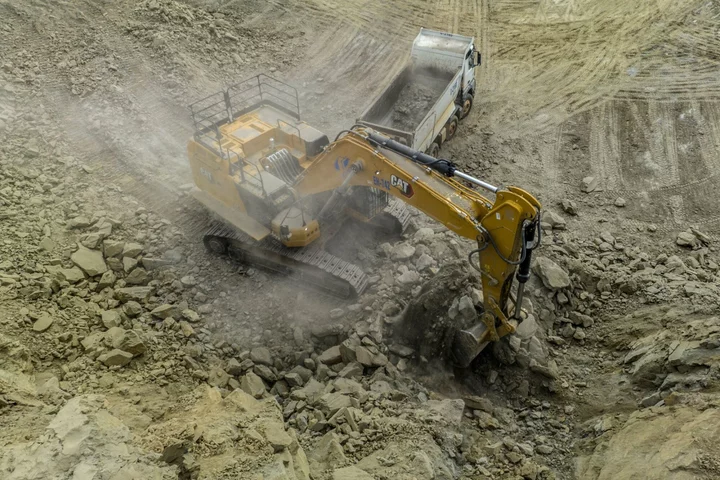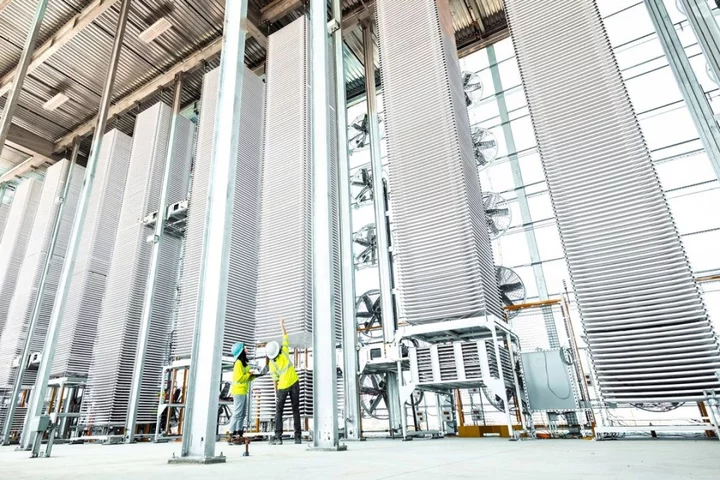
BOE’s Mann Says Climate Change Poses Persistent Inflation Threat
Both climate change and the path to net zero will cause higher, more persistent and more volatile inflation
2023-11-14 01:24

Exxon Aims to Become a Top Lithium Supplier for EVs by 2030
Exxon Mobil Corp. plans to become one of the biggest suppliers of lithium for electric vehicles, marking the
2023-11-14 01:00

Orsted Quits Norway Offshore Wind as Cost Crisis Deepens
Orsted A/S has withdrawn from a partnership developing offshore wind projects in Norway as the company grapples with
2023-11-14 00:53

Breakthrough device cleans dirty water and turns it into fuel
Scientists have built a breakthrough device that can clean dirty water and turn it into clean hydrogen fuel. The “simple” device could be used in areas without resources or places where people live off the grid. And it is just one example of the many solutions that will be required to respond to pollution and give people access to both clean fuel and water, the researchers behind it say. The system is inspired by photosynthesis, the process where plants turn light into food. But previous versions of those “artificial leaves” have required clean water sources – whereas the new device can be used with polluted water and even produce clean drinking water at the same time. As such, scientists believe that it could help solve two problems at once: making green fuel and cleaning water so that it is ready to drink. “Bringing together solar fuels production and water purification in a single device is tricky,” said Chanon Pornrungroj from the University of Cambridge, the paper’s co-lead author. “Solar-driven water splitting, where water molecules are broken down into hydrogen and oxygen, need to start with totally pure water because any contaminants can poison the catalyst or cause unwanted chemical side-reactions.” The system uses a carbon mesh to absorb light and heat, creating water favour that is then turned into hydrogen for fuel by a photocatalyst. That carbon mesh also repels water, so that the system can float and its important parts can be kept from being damaged by water. The device is also able to harness more of the Sun’s energy than previous examples, which have used only a small portion of the spectrum of light. The new system has a white layer on top to absorb UV rays, with the rest being used lower down to vaporise the water. “This way, we’re making better use of the light – we get the vapour for hydrogen production, and the rest is water vapour,” said Dr Pornrungroj. “This way, we’re truly mimicking a real leaf, since we’ve now been able to incorporate the process of transpiration.” The researchers behind the breakthrough noted that the system was simple to make, and was especially able to deal with very polluted water. As such, it could be a key way of working towards a sustainable future, they said – even though it is just a proof of concept for now. “The climate crisis and issues around pollution and health are closely related, and developing an approach that could help address both would be a game-changer for so many people,” said Cambridge’s Erwin Reisner, who led the work. The device is described in a new paper, ‘Hybrid photothermal-photocatalyst sheets for solar-driven overall water splitting coupled to water purification’, published in Nature Water today. Read More First carbon capture plant opens in the US to help avoid climate catastrophe Breakthrough solar system outperforms military-grade diesel generator Solar panel world record smashed with ‘miracle material’
2023-11-14 00:20

Nintendo warned over Legend of Zelda movie
Game designer Shigeru Miyamoto has issued a warning to Nintendo.
2023-11-13 23:27

Strauss Zelnick calls for gaming industry change
The gaming sector needs to overhaul its pricing philosophy, according to Strauss Zelnick.
2023-11-13 23:17

Fortnite Merch Black Friday 2023 Deals
Fortnite fans should snag these deals before they disappear!
2023-11-13 23:16

Astronauts dropped a toolbag in space which you can see with just binoculars
Whilst repairing external parts of the International Space Station (ISS) last week, astronauts dropped a toolbag. And it turns out you just need a pair of binoculars to see it. The bag is tiny compared to the ISS, but it's reflective enough that when it catches the Sun's light it reaches 6th magnitude from Earth according to Earthsky. Under very dark skies, some powerful binoculars or a small telescope might allow you to see the toolbag. The bag is moving at almost exactly the same speed as the ISS on the same path and about a minute ahead of it. Over time, however, its distance from the ISS will grow, making it harder to find. Eventually, its orbit will become low enough that it burns up from friction with the outer atmosphere. You can find out if you have the ISS passing overhead here if you want to have a chance of seeing the bag. The ISS can only be seen easily when it's dark on the ground and sunlight is still catching it. It means it's usually best seen when the skies are not fully dark - so around dusk or dawn. Here is what the toolbag looks like from space: Sign up to our free Indy100 weekly newsletter Have your say in our news democracy. Click the upvote icon at the top of the page to help raise this article through the indy100 rankings. How to join the indy100's free WhatsApp channel
2023-11-13 22:51

First carbon capture plant opens in the US to help avoid climate catastrophe
The first ever commercial-scale carbon capture facility has begun operations in the US, marking a significant milestone towards meeting cleaner climate targets. San Francisco-based startup Heirloom Carbon Technologies opened the carbon removal plant in Tracy, California, on Thursday, claiming it will be able to capture 1,000 metric tons per year of CO2. The renewable energy-powered plant leverages the natural power of limestone to remove CO2 from the atmosphere. “Rocks are some of the planet’s most vital carbon sinks. Over geological timescales, CO2 from the atmosphere binds to minerals and permanently turns to rock - a process known as carbon mineralisation,” Heirloom notes on its website. “Limestone is one of the most abundant rocks on the planet, capturing massive amounts of CO2 from the air over years, Heirloom’s technology accelerates this natural process to just days.” The process works by placing hundreds of trays of calcium oxide powder onto 12-metre-tall racks, which turns into limestone as it comes into contact with CO2 from the atmosphere. Workers then heat up the limestone, which releases the carbon dioxide and turns it back into calcium oxide that can be reused to capture more CO2. The atmospheric CO2 that is captured through the facility is permanently sequestered in concrete through a partnership between Heirloom and CarbonCure Technologies. Heirloom aims to remove 1 billion tons of CO2 from the atmosphere by 2035 using its Direct Air Capture technology, with funding coming from companies buying carbon removal credits in order to offset their own emissions. It is not the first company to achieve direct carbon capture from the atmosphere, but Heirloom claims to be the first in the US. Switzerland-based startup Climeworks AG has commercial facilities in Switzerland and Iceland, which are capable of removing 4,000 metric tons of CO2 each year. Carbon capture technologies have faced criticism for the large amounts of energy and resources they require to operate, though some scientists claim they will be a vital part of keeping global net emissions below zero by 2050. In response to criticism from green groups in 2021 claiming that such projects are a costly distraction, Professor Stuart Haszeldine from Edinburgh University said: “Carbon capture and storage is going to be the only effective way we have in the short term to prevent our steel industry, cement manufacture and many other processes from continuing to pour emissions into the atmosphere. “If we are to have any hope of keeping global temperature [increases] down below 2C then we desperately need to develop ways to capture and store carbon dioxide.” The US government announced in August that it would fund a $1.2 billion effort to develop and deploy carbon capture technologies, with Heirloom among the recipients. Major companies, including Microsoft, have already signed deals to purchase carbon removal credits from Heirloom. Read More Breakthrough solar system outperforms military-grade diesel generator Breakthrough solar system outperforms military-grade diesel generator Solar panel world record smashed with ‘miracle material’ Google issues three-week warning to Gmail account holders
2023-11-13 22:46

To Meet Climate Goals, Gulf Countries Will Have to Overhaul Everything
In Dubai, it’s normal to leave your air conditioning running at all times, even if you go away
2023-11-13 22:19

EU to Pledge ‘Substantial’ Sum to Climate Loss and Damage Fund
The European Union vowed “substantial” contributions to a fund aimed at helping vulnerable countries cope with severe weather,
2023-11-13 20:50

Eating strawberries can reduce the risks of dementia, study finds
A recent study has found that eating strawberries daily could reduce the risk of developing dementia. Researchers at the University of Cincinnati claim that by eating the fruit every day, certain people of middle age could reduce their risk of dementia. The 12-week study published in Nutrients had 30 overweight patients - who had complained of mild cognitive impairment - abstain from eating berries, aside from a daily packet of supplement powder mixed with water and consumed with breakfast. Half of the participants, who were 50 to 65 years old, received a powder that contained the equivalent of one cup of whole strawberries (the standard serving size), whilst the other half received a placebo. Participants' long-term memory, mood, and metabolic health were measured by researchers. The team found that those who had taken the strawberry powder had performed better on a wordlist learning test, as well as having a significant reduction in depressive symptoms. "Both strawberries and blueberries contain antioxidants called anthocyanins, which have been implicated in a variety of berry health benefits such as metabolic and cognitive enhancements," said Robert Krikorian, professor emeritus in the UC College of Medicine's Department of Psychiatry and Behavioural Neuroscience. "There is epidemiological data suggesting that people who consume strawberries or blueberries regularly have a slower rate of cognitive decline with ageing." Ellagitannins and ellagic acid are also found in strawberries, which are known to possess anti-inflammatory, antioxidant, antimicrobial, and anticancer properties. Krikorian went on to explain that strawberries may have improved cognitive function by reducing inflammation in the brain. "Executive abilities begin to decline in midlife and excess abdominal fat, as in insulin resistance and obesity, will tend to increase inflammation, including in the brain," he explained. The university did, however, acknowledge that Krikorian's research was partly funded by the California Strawberry Commission. Although said that the group had no role in the design of the study, data collection and analysis, or publication of the results. Sign up to our free Indy100 weekly newsletter Have your say in our news democracy. Click the upvote icon at the top of the page to help raise this article through the indy100 rankings. How to join the indy100's free WhatsApp channel
2023-11-13 20:48
